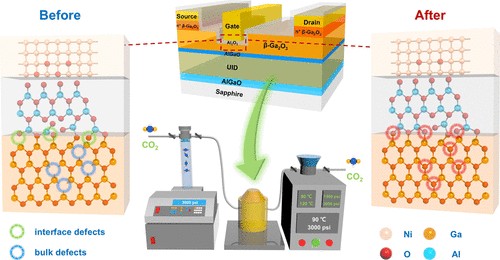

【Device Papers】Performance Improvement of (AlₓGa₁₋ₓ)₂O₃/Ga₂O₃ Heterostructure FET via Supercritical Isostatic Pressing-Induced Self-Redox
日期:2025-04-17阅读:450
Researchers from the School of Electronic and Computer Engineering, Guangdong Provincial Key Laboratory of In-Memory Computing Chips, Peking University have published a dissertation titled "Performance Improvement of (AlxGa1–x)2O3/Ga2O3 Heterostructure FET via Supercritical Isostatic Pressing-Induced Self-Redox" in ACS Applied Materials & Interfaces.
Abstract
Ultrawide-bandgap β-Ga2O3-based metal-oxide-semiconductor field-effect transistors (MOSFETs) are highly promising for ultrahigh-power applications due to their exceptional material properties. However, the performance of β-Ga2O3 MOSFETs is well below the theoretical limit of the materials, primarily constrained by intrinsic bulk defects in β-Ga2O3 and the lack of effective processing methods to enhance device performance. In this work, we designed and fabricated (AlxGa1–x)2O3/Ga2O3 heterostructure FET and developed supercritical isostatic pressure carbon dioxide (SCIP-CO2) technology to induce a self-redox reaction within the device under a three-dimensional isostatic pressure environment. Through self-oxidation and reduction, SCIP-CO2 treatment effectively repairs dangling bonds, reducing defects within the materials to improve device performance. This process uses only the O atoms generated by the self-reducing reaction in the Ni and Al2O3 layers of the device to repair the defects, and no other substances are introduced. Following SCIP-CO2 treatment, the devices exhibited a substantial increase in on-current, a reduction in the subthreshold swing (from 500 to 440 mV/dec), enhanced transconductance (from 15.9 to 24.3 μS), a decrease in the interface defect density from 6.5 × 1012 to 2.4 × 1012 cm–2, and a marked reduction in gate leakage. This proves that SCIP-CO2 treatment can further enhance device performance after the device has completed the fabrication process. The comprehensive optimization of the electrical performance of devices demonstrates the enormous potential of SCIP-CO2 technology for next-generation power electronic devices.
DOI:
https://doi.org/10.1021/acsami.4c21796


